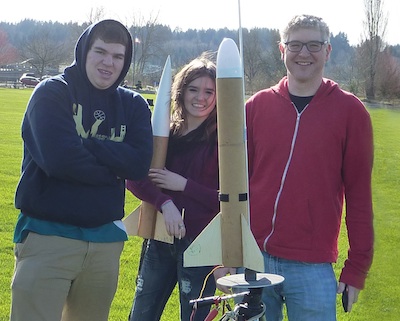By Gwen Davis , JTNews Correspondent
In early spring, the AP physics class at the Northwest Yeshiva High School was one of only 100 teams around the world to qualify for the 2013 Team America Rocketry Challenge (TARC). However, May 11, when the team would fire its rocket, is a Saturday — Shabbat.
For several days it was unclear whether the team would be given an accommodation to fire its rocket without violating Shabbat, but as of April 19, the team’s teacher, Peter Brodkin, said he was confident an accommodation would be made.
“As of this moment, I think we will be able to do it,” he said. “It’s just a question of needing to keep with the rules of the competition and keep with the rules of Shabbat.”
TARC has been very accommodating, Brodkin said.
“They’ve been very helpful and sympathetic to the cause. They are allowing us to prepare our rocket on Friday before Shabbat, and then on Saturday, someone will press the button for us, and we will just be observers.”
This is not the first time the Orthodox high school has run into accommodation issues due to Jewish holidays. In 2010, the girls’ basketball team qualified to compete at the state championship in Yakima, yet their first game fell on the Fast of Esther. The Washington Interscholastic Activities Association refused to provide an accommodation for the team to play on another day. After much ado, the team forfeited the game and lost its seeding.
Those associated with the school feared the same fate would befall the rocket team. But, at least by press time, will likely be the case, at this time.
Whether they travel to Washington, D.C. or not to compete, the rocket team’s accomplishment is celestial. A qualifying rocket needed to hit an altitude of 750 feet, have a total flight time of 48 to 50 seconds and recover a raw egg safely with a 15-inch parachute.
NYHS’s rocket soared 752 feet and descended in 46 seconds, close enough to target. NYHS joined a record-setting 725 other teams from Spain to California to make the challenge.
Team members Jessica Schwartz, Joel Jacobs and Itai Amon designed their approach using computer simulations to determine the optimal design, weight, and type of engine.
“We built this rocket competition into the curriculum as a way to get real-world application of theories,” Brodkin said. “A couple of years ago the National Association of Rocketry sent me a flyer, talking about this specific competition. Last year we didn’t qualify, but we learned a lot and had a lot of fun.”
This year, NYHS had two teams. One qualified. Brodkin said the team accomplished this feat due to its perseverance.
“We spent a number of Sundays and many hours outside of class,” he said. “They are a very determined group. They made this happen.”
Brodkin said the team gave its all to the project, both academically and with the labor involved.
“We made the design on the computer that’s supposed to get us in the ball park,” Brodkin said. “But when you build the rockets it doesn’t come out as nicely as the computer suggests it will. Once you launch, you keep having to launch and launch until you get it right.”
TARC is the world’s largest rocket contest, sponsored by the Aerospace Industries Association and the National Association of Rocketry. It was created in 2002.
Approximately 7,000 students from across the nation compete in TARC each year. Teams design, build and fly a model rocket that reaches a specific altitude and duration determined by a set of rules developed each year. The contest is designed to encourage students to study math and science and pursue careers in aerospace. TARC has been growing every year in both attendees and prizes.
The top 100 teams, based on local qualification flights, are invited to Washington, D.C. in May for the national finals. Prizes include $60,000 in cash and scholarships split between the top 10 finishers. NASA invites top teams to participate in its Student Launch Initiative, an advanced rocketry program.
